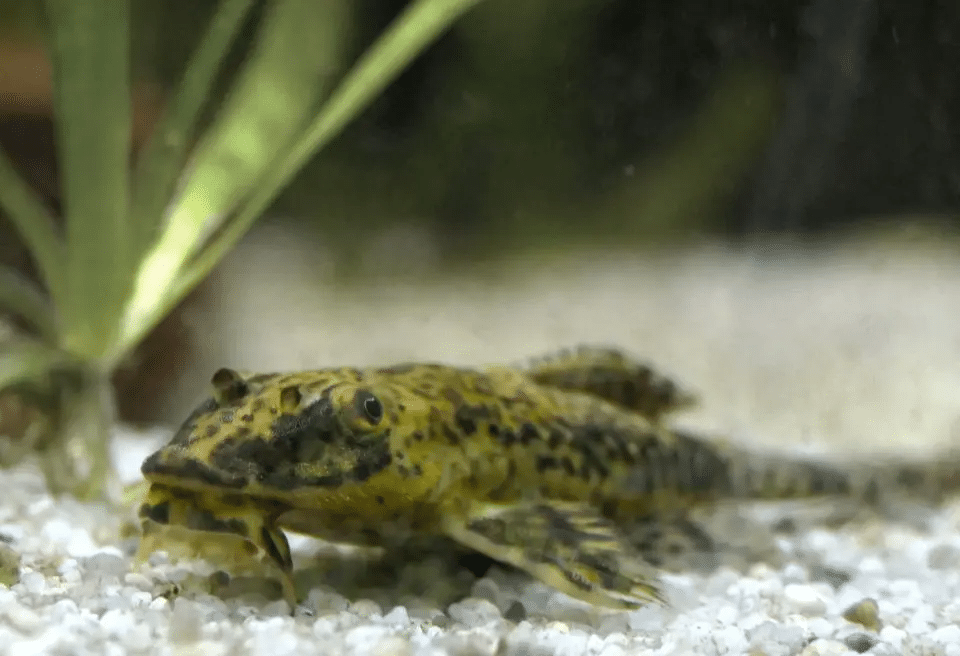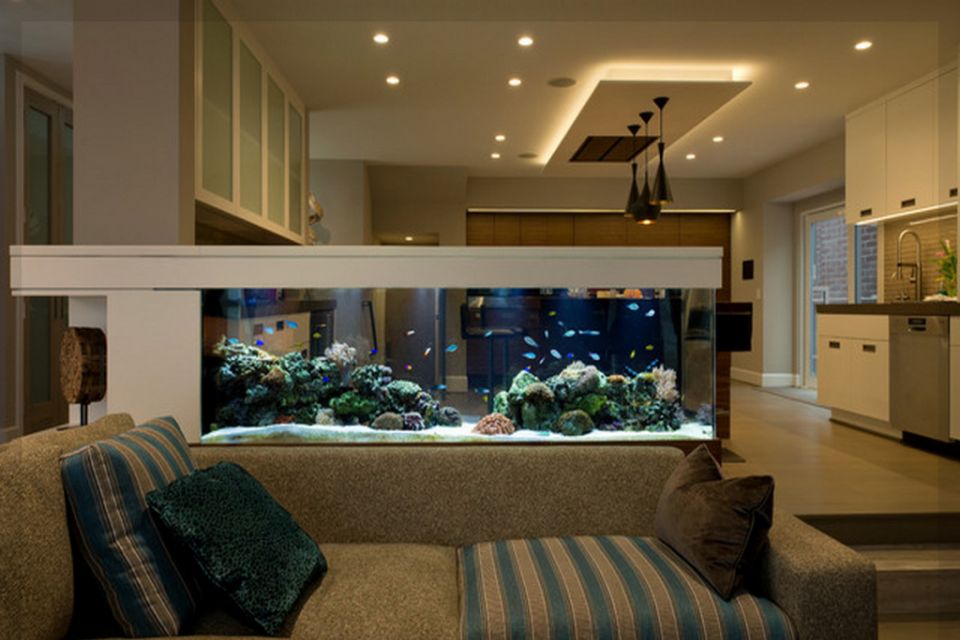
In this aquarium guide article we show you the most important information about the popular Whiptail catfish and go into detail about keeping, socializing and breeding in the aquarium.
Table of Contents
The most important facts about the Whiptail catfish in a nutshell
- Whiptail catfish should be kept in a group of at least 4-5 animals
- In nature, Whiptail Catfishlives in very clean streams with strong currents (oxygen-rich water)
- The Whiptail -catfish can show either a gray-brown or a reddish color with a pattern
- Whiptail -catfish become approximately 12 cm long
- The peaceful Whiptail Catfish likes to live together with other peaceful fish species. However, one should note that the Whiptail catfish is an omnivore and grows considerably larger than many of the small freshwater ornamental fish
- The animals like to hide, so that a lot of hiding places should be offered

Portrait of the Whiptail Catfish
The Whiptail catfish has a grey-brown colour and a pattern of different light and darker shades. There is also a red breeding form of the Whiptail catfish. The animals usually grow to about 12 cm in size, with the pronounced anus making up the largest part of the body length. Males and females can be easily distinguished in this fish species: The male Whiptail catfish have bristles on the sides of the mouth. The upper and lower lip of the Whiptail catfish are evenly developed.

Where is the Whiptail catfish?
As mentioned at the beginning of the article, the Whiptail catfish originates from South America. There it lives in the La Plata region in narrow, torrential streams, which are usually not deeper than 10 centimeters. This region begins in parts of Uruguay as well as Brazil, extends partly over Argentina and ends at the border to Paraguay. The Whiptail catfish feels especially comfortable on flat sandbanks, which are very clean and rich in oxygen.

How do you keep Whiptail catfish in an aquarium?
Whiptail catfish are not particularly demanding aquarium ornamental fish and are therefore also suitable for aquarium beginners. It is especially important to offer Whiptail catfish sufficient hiding places. Tubes and slates are particularly suitable for this purpose, as they can be purchased at a reasonable price in a DIY store and are also well suited to the typical habitat of the animals. But also decoration objects, such as roots or stones are gladly accepted by the Whiptail catfish as a place of retreat.
Whiptail catfish can be kept in aquariums from an edge length of 120 cm, because thanks to its size Whiptail catfish needs enough surface area to move around. Ideal are also current aquariums or stream aquariums – two special aquarium constructions, which usually have a width-length ratio in favour of the length of the aquarium. If possible the aquarium should be equipped with a sandy bottom to protect the barbels of the animals from injury.

In order to maximize the hiding places for the animals, you should also use dense background planting in the aquarium. This can consist of slow-growing South American species, such as the Amazon sword plant, but also fast-growing species. As with the decoration, you should of course orientate yourself on the original habitat of the Whiptail Catfish.
The perfect tank for the Whiptail catfish should also not have too bright lighting: the home waters of the animals are relatively dark. This can easily be achieved with modern aquarium LED lights, for example, which can be dimmed.

Which water values does the Whiptail Catfish need?
Whiptail catfish are not particularly demanding aquarium ornamental fish when it comes to the classic water parameters. With the following water parameters the animals feel particularly well in the aquarium:
| Total hardness | 5-20° dHG |
| Carbonate hardness | 2-10° dKH |
| pH value | 6,0 – 7,5 |
| Temperature | 24-28° Celsius |
For keeping Whiptail catfish in an aquarium, the ideal temperature of the aquarium water is between 24 and 28°C. Especially South American ornamental fish adapt well to this particularly high temperature, which is why such animals should be considered when socializing.
A very clean and oxygen-rich aquarium water is also of great importance, because only then the Whiptail Catfish feels well and lives a long, healthy life. The pH-value should absolutely be between 6.0 and 7.5, the water should have a total hardness of 5 to 18°dGH.

How many Whiptail catfish keep in the aquarium?
The question of stocking density often causes difficulties for many aquarists. For this reason we have published a special guidebook article, which gives you some information about the optimal stocking density/stocking quantity in the aquarium.
Especially with group animals, like the Whiptail -catfish, the number of animals plays an especially important role, because only then the animals will be able to live out and show their distinctive social behavior. If too few animals are present, this is mostly noticeable by particularly shy Whiptail catfish. The already shy animals will then hardly show themselves at all.
In a 240 liter aquarium with an edge length of 120 centimeters 4-5 Whiptail catfish can be kept. If the animals are already large enough to distinguish between the sexes at the time of purchase, you should bet on a surplus of females. In case of a group of 5 Whiptail-catfish you should use 2 males and 3 females.

Since the Whiptail catfish is known as a particularly peaceful species, it should also live together with other peacefully minded fish. Especially South American characins, like the red neon or the Ember tetra are ideal for socializing.
Especially in smaller aquariums, you should not use any additional species that form territories, such as ram cichlids. Like many catfish species, Whiptail catfish do not know any remorse for invading other territories – this leads to additional stress for the other species and destroys all possible breeding successes.
Whiptail catfish can otherwise also be very well socialized with shrimps and snails.

What does the Whiptail catfish eat?
Whiptail catfish eats algae on stones, slices and plants. Flake food and food tablets are also readily accepted by the animals. Whiptail catfish are omnivores, so it can happen that even live food is consumed on the bottom of them. It is also possible to feed the Whiptail catfish with fresh, boiled vegetables.
It is of great importance that the Whiptail catfish are fed a varied diet to meet the nutritional needs of the animals. It is also recommended to feed Whiptail catfish in the dark in the evening, when the lighting of the aquarium is already extinguished. This ensures that the animals get enough food.

How do you breed Whiptail catfishes?
If the aim is to breed Whiptail catfish in an aquarium, the fish must have at least a 4 × 20 centimetre spawning burrow at their disposal. Alternatively, a bamboo tube with a diameter of three to four centimetres will be perfectly suitable for Whiptail catfish . The female Whiptail catfish lays its eggs in such a tube or cave and then leaves it again. The male then seeks the eggs and fertilises the spawn.
Conclusion: Keeping Whiptail catfishes in the aquarium is not difficult
The keeping of the Whiptail-catfish is certainly not complicated, why the animals are very well suitable also for aquaristic beginners. Nevertheless, one should keep some criteria, so that the optimal keeping conditions are fulfilled. On the one hand you need an aquarium with an edge length of at least 120 centimeters, on the other hand the preference of the Whiptail catfish for tanks with strong currents must be considered.
The omnivores should in any case be fed a varied diet and should also be fed with food other than typical aquarium food. Especially recommended is brown autumn leaves, green food, frozen food or vegetables. If not fed sufficiently, the Whiptail catfishes often eat plants and ruins them.
Whiptail catfish should be kept in a group of 4-5 animals, at best with female surplus. The animals can be socialized very well with South American calm species, which can adapt to their preference for current. Territory forming species that inhabit the ground should be avoided completely, especially in smaller aquarium.
If the criteria are met and the animals are kept in the best possible conditions, the aquarist can enjoy the animals for a long time: the age expectancy is about fourteen years.



